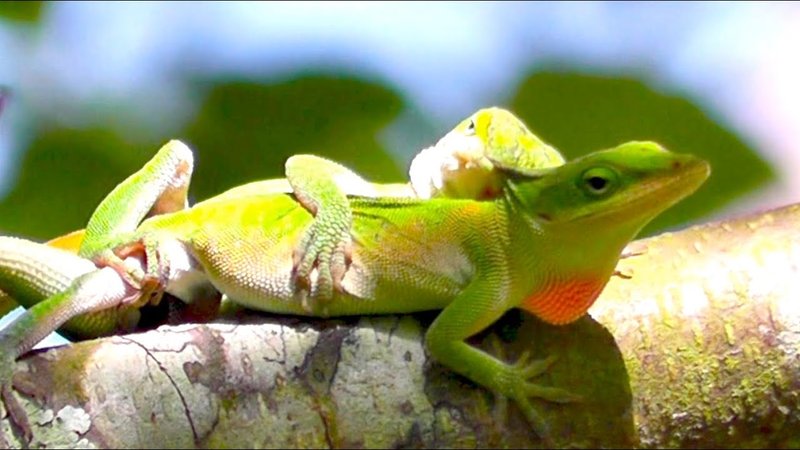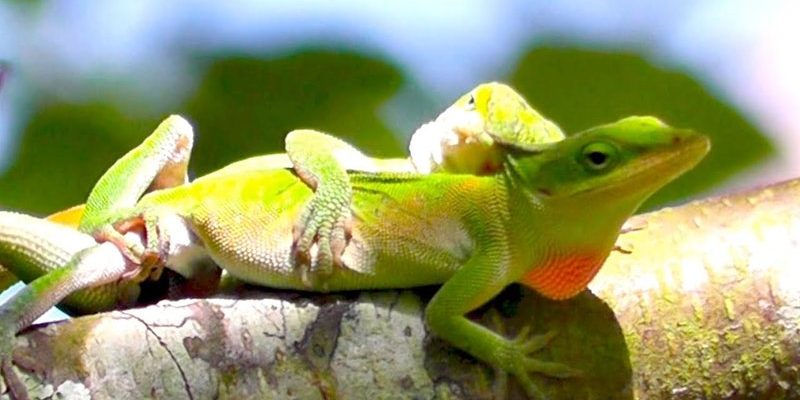
Anoles belong to the family Dactyloidae and are particularly notable for their mating rituals. These lizards are divided into various species, with the green anole (Anolis carolinensis) and the brown anole (Anolis sagrei) being two of the most common. Each species has its distinct traits and behaviors, but they share some remarkable reproductive patterns. So, let’s dive into the intriguing world of anole lizards and discover how they find mates, build nests, and rear the next generation.
Anole Lizard Mating Rituals
Just like a dance-off at a party, male anoles have their own way of showing off to attract females. During the breeding season, which typically runs from spring to summer, males become more vibrant in color and display behaviors that are both fascinating and strategic.
One of the most notable features of male anoles is their dewlap—a colorful flap of skin under their throat. They puff this out to signal to potential mates and rivals. Imagine a peacock spreading its feathers; it’s their way of saying, “Look at me!” This display is often accompanied by head bobs and push-ups, which make them appear larger and more intimidating to other males.
Here’s the thing: these rituals aren’t just for show. They play a vital role in attracting females. A female anole is more likely to choose a male who can perform an impressive display. So, think of it as nature’s way of ensuring the strongest genes get passed on.
Competition Among Males
Competition is a big part of the mating process for anole lizards. When multiple males are vying for the attention of a female, they engage in a series of competitive displays. This can include chasing each other, fighting, or performing more elaborate displays.
Sometimes, you might see two males in a standoff, each trying to outdo the other. The winner gets to mate with the female. It’s a classic case of “survival of the fittest,” where only the most capable males get to pass on their genes. This behavior not only ensures that the strongest males breed but also contributes to the overall health of the population.
Nesting and Egg-Laying Behavior
Once a female has chosen her mate, it’s time for the next step: nesting. Female anoles typically lay their eggs in small clutches, often ranging from 1 to 15 eggs per clutch, depending on the species and environmental conditions.
They prefer to lay their eggs in moist, sheltered locations like under leaf litter or in soft soil. This choice not only protects the eggs from predators but also ensures they have the right temperature and humidity for development. Anole eggs are usually leathery rather than hard, allowing them to retain moisture while they incubate.
Interestingly, anole females can store sperm from their mates for several weeks, allowing them to fertilize multiple clutches from a single mating event. This ability gives them more control over their reproductive outcomes, ensuring that they can select the best conditions in which to lay their eggs.
Incubation and Hatching
The incubation period for anole eggs typically lasts around 4 to 8 weeks, depending on environmental factors such as temperature and humidity. While the eggs develop, the female may not stay close by, but she does keep an eye on the nesting site.
Once the eggs hatch, tiny juvenile lizards emerge and are immediately independent. They’re miniature versions of their parents, ready to scurry away and find food without any parental care. This rapid self-sufficiency is crucial for survival in the wild, where predators are abundant.
Juvenile anoles often hide in vegetation to avoid being eaten and quickly learn to hunt for insects, their primary food source.
Seasonal Breeding Patterns
Breeding patterns in anole lizards largely depend on their environment. In warmer climates, breeding can happen year-round, while in cooler areas, it’s usually confined to the warmer months. The availability of resources, like food and suitable nesting sites, plays a crucial role in determining when and how often breeding occurs.
During the breeding season, males become more aggressive in defending their territories. They mark their territory with scents and engage in displays to ward off other males. This territorial behavior ensures that they have enough resources to support both themselves and potential offspring.
Here’s the deal: the timing of breeding is all about survival. By aligning reproduction with the best environmental conditions, anoles increase the likelihood of their young surviving to maturity.
Environmental Influences on Reproduction
Environmental factors can significantly affect the reproductive behavior of anole lizards. For instance, temperature changes can influence breeding timing and egg development. Warmer temperatures often lead to earlier breeding seasons, while cooler conditions can delay them.
Additionally, changes in habitat can impact anole populations. Habitat destruction or alterations can reduce the availability of nesting sites, which may lead to lower reproductive success. It’s essential for conservation efforts to consider these factors to help preserve anole populations in their natural habitats.
Behavior After Mating
After mating, male anoles usually don’t play a role in caring for the young. Rather, their focus shifts toward maintaining their territory and competing for other mates. In contrast, females expend a lot of energy laying eggs and ensuring they’re placed in safe locations.
The focus on reproduction without parental care is an interesting strategy in the animal kingdom. It allows females to conserve resources for future breeding. This can lead to females laying multiple clutches in a season, maximizing their reproductive output.
Here’s a quirky aspect: sometimes, females may even engage in sneaky mating. They might mate with multiple males to increase their chances of fertilizing their eggs with the best genetic material. It’s a bit of a reproductive strategy that ensures diversity in the gene pool.
Understanding the breeding and reproductive behavior of the anole lizard offers insight into how these fascinating creatures navigate their world. From the males’ colorful displays to the females’ strategic egg-laying, every aspect of their reproductive strategy is a testament to the complexity of nature.
Whether you’re a budding herpetologist or simply a curious observer of wildlife, watching anoles can be a captivating experience. So next time you see one basking in the sun, imagine the vibrant world of courtship and competition happening just below the surface. In the grand dance of life, anoles continue to play their part, showcasing the beauty of survival in the wild.

